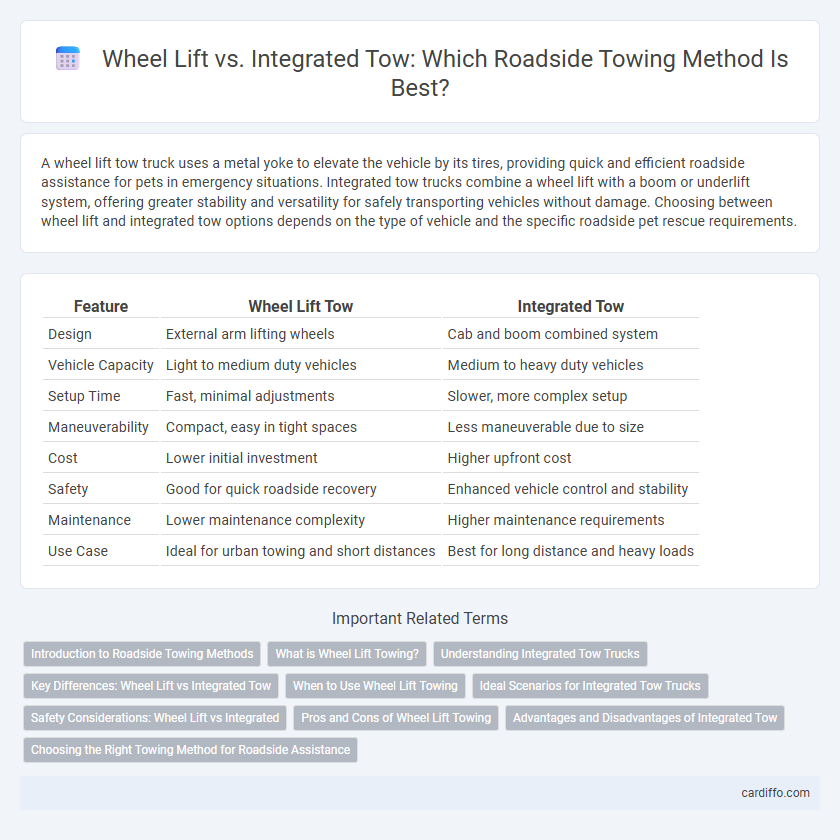A wheel lift tow truck uses a metal yoke to elevate the vehicle by its tires, providing quick and efficient roadside assistance for pets in emergency situations. Integrated tow trucks combine a wheel lift with a boom or underlift system, offering greater stability and versatility for safely transporting vehicles without damage. Choosing between wheel lift and integrated tow options depends on the type of vehicle and the specific roadside pet rescue requirements.
Table of Comparison
| Feature | Wheel Lift Tow | Integrated Tow |
|---|---|---|
| Design | External arm lifting wheels | Cab and boom combined system |
| Vehicle Capacity | Light to medium duty vehicles | Medium to heavy duty vehicles |
| Setup Time | Fast, minimal adjustments | Slower, more complex setup |
| Maneuverability | Compact, easy in tight spaces | Less maneuverable due to size |
| Cost | Lower initial investment | Higher upfront cost |
| Safety | Good for quick roadside recovery | Enhanced vehicle control and stability |
| Maintenance | Lower maintenance complexity | Higher maintenance requirements |
| Use Case | Ideal for urban towing and short distances | Best for long distance and heavy loads |
Introduction to Roadside Towing Methods
Wheel lift towing uses a metal yoke to lift the vehicle by its tires, providing a quick and efficient method suited for short-distance transport and minimal vehicle contact. Integrated tow systems feature a built-in boom or wheel lift mechanism on a single truck, offering enhanced stability and versatility for handling various vehicle sizes and complex towing scenarios. Both methods are essential in roadside towing operations, addressing different recovery needs based on vehicle type and damage severity.
What is Wheel Lift Towing?
Wheel lift towing uses a metal yoke that slides under the vehicle's wheels, lifting them off the ground for secure transport. This method is ideal for quick, efficient towing of cars and smaller vehicles without fully lifting the chassis. Wheel lift systems reduce the risk of drivetrain damage compared to traditional hook and chain towing.
Understanding Integrated Tow Trucks
Integrated tow trucks utilize a boom and wheel lift combined into a single unit, providing enhanced stability for heavy-duty vehicle recovery. Unlike traditional wheel lifts that only engage the wheels, integrated systems secure the entire front or rear end of the vehicle, reducing the risk of damage during towing. This design is especially effective for recovering buses, emergency vehicles, and other heavy apparatus on the roadside.
Key Differences: Wheel Lift vs Integrated Tow
Wheel Lift tow trucks use a hydraulic mechanism to lift vehicles by their wheels, making them suitable for lighter loads and short-distance tows, while Integrated Tow trucks combine a wheel lift and boom in one unit providing enhanced stability and capability for heavier vehicles and complex recovery scenarios. Wheel Lift trucks offer quicker hook-ups and lower costs, whereas Integrated Tow trucks deliver superior control and are favored for commercial vehicle towing and long-distance transport. The choice between Wheel Lift and Integrated Tow depends on the vehicle type, tow length, and recovery requirements.
When to Use Wheel Lift Towing
Wheel lift towing is ideal for short-distance vehicle recovery, especially when the towed vehicle has a functional suspension and tires capable of bearing weight without damage. This method is preferred for quick roadside assistance, light-duty towing, and situations where minimal handling of the vehicle is required. Avoid wheel lift towing for extended trips or vehicles with severe suspension damage, as it may cause further mechanical issues.
Ideal Scenarios for Integrated Tow Trucks
Integrated tow trucks excel in high-clearance vehicle recovery, making them ideal for luxury cars, SUVs, and sports cars where undercarriage damage risk is a concern. Their hydraulic lifts provide efficient, damage-free towing on steep inclines and busy urban streets. These trucks are preferred by roadside assistance services handling accidents with severely damaged vehicles needing secure and stable transport.
Safety Considerations: Wheel Lift vs Integrated
Wheel lift systems minimize ground contact by lifting only the front or rear wheels, reducing damage risk to the vehicle and improving safety during short-distance moves. Integrated tow systems offer enhanced stability by securing the entire vehicle, preventing accidental drops and providing superior control on uneven terrain. Choosing the right method depends on vehicle condition and the towing environment to maximize safety and prevent further damage.
Pros and Cons of Wheel Lift Towing
Wheel lift towing offers a cost-effective solution with quicker hookup times and less vehicle wear compared to integrated tow systems, enhancing efficiency in roadside recoveries. However, it provides limited stability for heavy-duty or long-distance towing and can cause additional stress on a vehicle's suspension, risking damage during transport. Operators must balance affordability and speed against the potential for reduced safety and increased mechanical strain when choosing wheel lift towing.
Advantages and Disadvantages of Integrated Tow
Integrated tow systems offer enhanced stability and safety by securely lifting the entire front or rear end of a vehicle, reducing the risk of further damage during transport. However, these systems tend to be heavier and more expensive than wheel lifts, requiring additional maintenance and specialized training for operators. Despite higher upfront costs, integrated tows provide superior protection for vehicles, making them ideal for delicate or luxury cars needing secure roadside assistance.
Choosing the Right Towing Method for Roadside Assistance
Selecting the appropriate towing method for roadside assistance depends on vehicle type, weight, and damage condition. Wheel lift tow trucks are effective for quick, lightweight tows without lifting the entire vehicle, preserving the drive wheels. Integrated tow trucks provide enhanced stability and safety for heavier vehicles or those with severe damage by fully supporting the vehicle during transport.
Wheel Lift vs Integrated Tow Infographic

 cardiffo.com
cardiffo.com